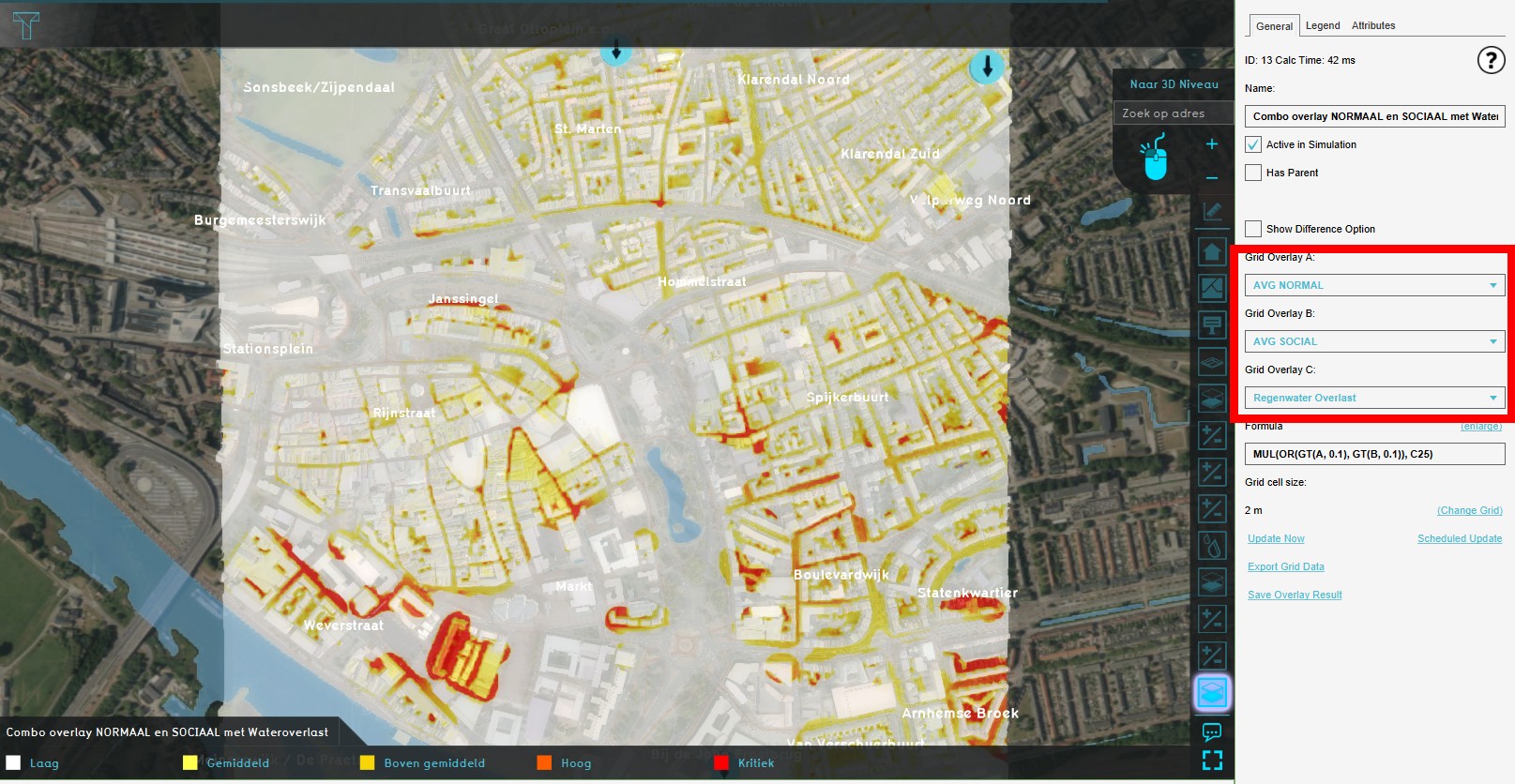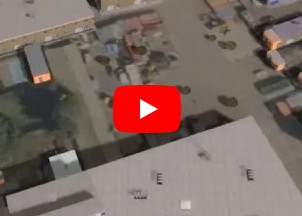Combo Overlay: Difference between revisions
No edit summary |
|||
| Line 54: | Line 54: | ||
===Timeframes=== | ===Timeframes=== | ||
* | When an input Overlay has multiple [[Timeframe]]s, additional syntax is available to specify the intended timeframes. | ||
{|class=wikitable | |||
! Syntax | |||
! Meaning | |||
! Example | |||
! Effect | |||
|- | |||
| A | |||
| The (last) value from Overlay A | |||
| MUL(A, 10) | |||
| Assuming: | |||
*A is a [[Water Overlay]] with [[Surface last value result type (Water Overlay)|Surface Last Value]] as result type | |||
Will show the height of the water at the end of the calculation in cm (rather than m). | |||
|- | |||
| A2 | |||
| The third timeframe's value from Overlay A | |||
| GT(A2, 38) | |||
| Assuming: | |||
*A is a [[Heat Overlay]] with [[Pet result type (Heat Overlay)|Physiological Equivalent Temperature]] as result type | |||
Will indicate whether any given location is (1) or is not (0) hotter than 38 {{celsius}}, on the third computed timeframe of the [[Heat Overlay]]. | |||
|- | |||
| A0:2 | |||
| The values from the first through third timeframes from Overlay A, as a list of inputs | |||
| AVG(A0:2) | |||
| Assuming: | |||
*A is a [[Heat Overlay]] with [[Pet result type (Heat Overlay)|Physiological Equivalent Temperature]] as result type | |||
Will show the average of the computed temperatures of the first three timeframes of the [[Heat Overlay]]. | |||
|- | |||
| AT | |||
| For each timeframe of the Combo Overlay, the value from that same timeframe from Overlay A, as individual inputs. | |||
This will cause the Combo Overlay to have at least as many timeframes as Overlay A. | |||
| MUL(AT, 10) | |||
| Assuming: | |||
*A is a [[Water Overlay]] with [[Surface last value result type (Water Overlay)|Surface Last Value]] as result type | |||
Will show the height of the water at each timeframe of the [[Water Overlay]]'s calculations in cm (rather than m). | |||
|} | |||
A [[Combo Overlay]] automatically computes the amount of [[timeframe]]s it requires, based on whether (and which of) its input Overlays are references with a "T" syntax. | |||
==Examples== | ==Examples== | ||
Revision as of 14:48, 19 January 2022

The combo overlay is a Grid Overlay which can combine up to three Grid Overlays with boolean operators and use these overlays as input arguments functions and operators. The list of available functions and operators is given in the chapter below. Combo overlays can also take other combo overlays as input. Another powerful combination is the use of combo overlays with Average Overlays (with or without an average distance).
Operators
In the table below are the operators displayed that are supported by the combo overlay. The term argument refers to a grid overlay configured as input, a numerical value or a global name.
| Name | Arguments | Type | Displays |
|---|---|---|---|
| SIN | Single | Sine function | |
| COS | Single | Cosine function | |
| TAN | Single | Tangent function | |
| ASIN | Single | Arc sine function | |
| ACOS | Single | Arc cosine function | |
| ATAN | Single | Arc tangent function | |
| ROUND | Single | Round function | |
| FLOOR | Single | Floor function | |
| CEIL | Single | Ceil function | |
| ABS | Single | Absolute function | |
| EXP | Single | Exponential function | |
| LN | Single | The natural logarithm (base e) function | |
| LOG | Single | The natural logarithm (base 10) function | |
| SQRT | Single | The square root function | |
| RANDOM | Single | The random function, which returns a number greater than or equal to 0.0 and less than the provided argument | |
| ERF | Single | The gauss error function, for probability calculations. | |
| ADD | Multi | Add one or more argument | |
| MULT | Multi | Multiply one or more arguments | |
| SUB | Multi | Subtract one or more arguments from the first argument | |
| DIV | Multi | Divide the first argument with one or more other arguments | |
| MIN | Multi | Returns the smallest of the provided arguments. That is, the result is the argument closest to negative infinity. | |
| MAX | Multi | Returns the largest of the provided arguments. That is, the result is the argument closest to positive infinity. | |
| POW | Multi | Raises the first argument to the power of the consecutive arguments. For example 2 to the power 3 to the power 4. | |
| IF | Multi | Takes 3 arguments. If first argument is exactly 1, returns the second argument, else return the third argument. | |
| OR | Multi | Returns 1.0 if any argument is not equal to 0.0. | |
| AND | Multi | Returns 1.0 if all arguments are not equal to 0.0. | |
| GTE | Pair | Returns 1.0 if the first argument is larger than or equal to the second argument, else returns 0.0. | |
| GT | Pair | Returns 1.0 if the first argument is larger than the second argument, else returns 0.0. | |
| LTE | Pair | Returns 1.0 if the first argument is smaller than or equal to the second argument, else returns 0.0. | |
| LT | Pair | Returns 1.0 if the first argument is smaller than the second argument, else returns 0.0. | |
| NEQ | Pair | Returns 1.0 if the first argument is not equal to the second argument, else returns 0.0. | |
| EQ | Pair | Returns 1.0 if the first argument is equal to second argument, else returns 0.0. | |
| NO_DATA | Constant | The NO_DATA value for grid data, indicating no data exists. |
Input overlays and timeframes
- Up to three overlays can be configured as input for the combo overlay. They are referenced as A, B and C.
- You can use Globals in a formula.
Timeframes
When an input Overlay has multiple Timeframes, additional syntax is available to specify the intended timeframes.
| Syntax | Meaning | Example | Effect |
|---|---|---|---|
| A | The (last) value from Overlay A | MUL(A, 10) | Assuming:
Will show the height of the water at the end of the calculation in cm (rather than m). |
| A2 | The third timeframe's value from Overlay A | GT(A2, 38) | Assuming:
Will indicate whether any given location is (1) or is not (0) hotter than 38 °C, on the third computed timeframe of the Heat Overlay. |
| A0:2 | The values from the first through third timeframes from Overlay A, as a list of inputs | AVG(A0:2) | Assuming:
Will show the average of the computed temperatures of the first three timeframes of the Heat Overlay. |
| AT | For each timeframe of the Combo Overlay, the value from that same timeframe from Overlay A, as individual inputs.
This will cause the Combo Overlay to have at least as many timeframes as Overlay A. |
MUL(AT, 10) | Assuming:
Will show the height of the water at each timeframe of the Water Overlay's calculations in cm (rather than m). |
A Combo Overlay automatically computes the amount of timeframes it requires, based on whether (and which of) its input Overlays are references with a "T" syntax.
Examples
- Combo Overlay with average overlays
- Combo Overlay with masking
- Combo Overlay with distance filtering
How-to's
- How to add and remove an Overlay
- How to edit a Combo Overlay's formula
- How to edit an overlay legend
- How to add and remove an Attribute
Videos
